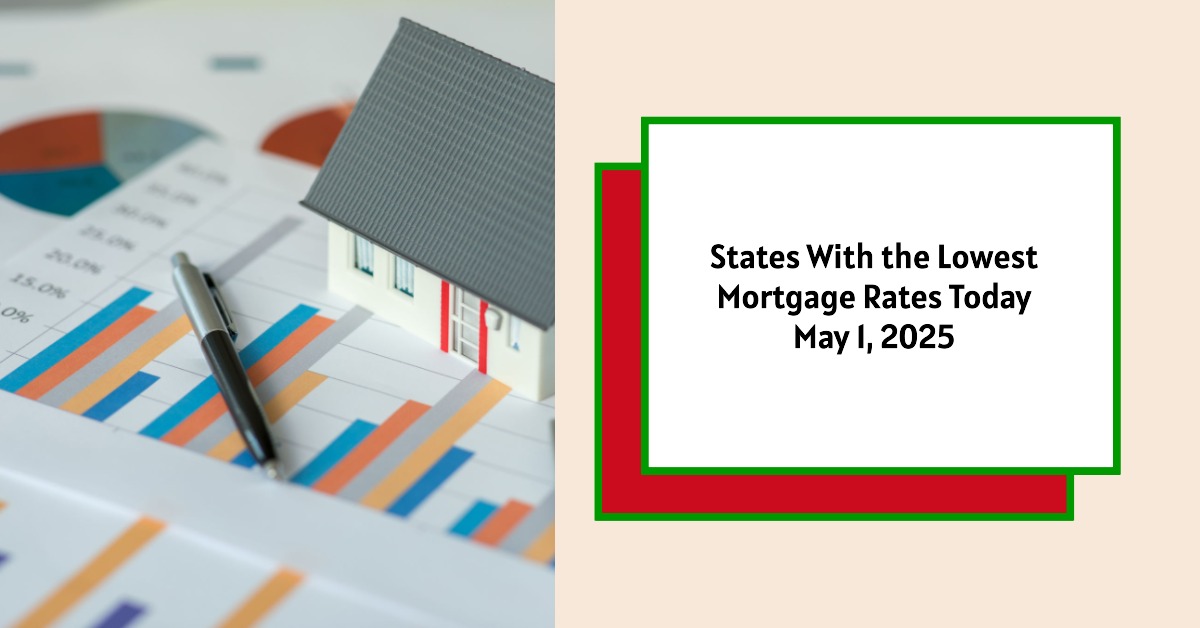Looking for the states where you can snag the cheapest mortgage rates right now? As of today, May 1, 2025, the states boasting the lowest 30-year mortgage rates are New York, Texas, Florida, Pennsylvania, Washington, Arizona, New Jersey, and Utah, with average rates ranging from 6.68% to 6.88%. This might be just the information you need to kickstart your home-buying journey!
States With the Lowest Mortgage Rates Today – May 1, 2025
Buying a home is a huge decision, and one of the biggest factors is, of course, the mortgage rate. It can feel like you're trying to solve a complex puzzle, especially with rates constantly changing. Today, let's take a closer look at which states are offering the most attractive mortgage rates, why rates fluctuate, and how you can secure the best deal possible for you.
Current Mortgage Rate Snapshot: May 1, 2025
Okay, so we know which states have the lowest rates, but let's zoom out and look at the bigger picture. Nationally, the average rate for a 30-year new purchase mortgage is hovering around 6.90%. While this is a slight increase from a recent low, it's still important to keep things in perspective. We've seen rates significantly higher this year, reaching as high as 7.14% earlier in May 2025.
Here's a quick rundown of national averages for different loan types, as of today (Source: Zillow):
- 30-Year Fixed: 6.90%
- FHA 30-Year Fixed: 7.33%
- 15-Year Fixed: 5.93%
- Jumbo 30-Year Fixed: 6.83%
- 5/6 ARM: 7.03%
Why Do Mortgage Rates Vary by State?
Ever wonder why your neighbor in another state might get a completely different mortgage rate than you? It's not just random chance. Several factors contribute to these state-by-state variations:
- Lender Presence: Not all lenders operate in every state. The level of competition among lenders can significantly influence rates. More competition often leads to lower rates.
- Credit Score Averages: States with higher average credit scores tend to see lower rates. Lenders view borrowers in these states as less risky.
- Average Loan Size: The average mortgage amount requested can influence interest rates.
- State Regulations: Each state has its own set of rules and regulations regarding mortgages, which can impact lender costs and, subsequently, rates.
- Risk Management: Different lenders have different risk management strategies. Some are more conservative than others, which can reflect in the rates they offer.
States with the Lowest Mortgage Rates: A Deeper Dive
Let's take a closer look at some of the states currently offering the most attractive mortgage rates:
- New York: Often a competitive market with a diverse range of lenders.
- Texas: A large and active housing market, leading to strong competition among lenders.
- Florida: A popular destination for retirees and families alike, driving mortgage demand.
- Pennsylvania: Stable housing market with a mix of urban and rural areas.
- Washington: Strong economy and growing population, leading to a healthy mortgage market.
- Arizona: Growing state with a strong influx of new residents
- New Jersey: Competitive market because of it's proximity to New York.
- Utah: Another growing state with new construction
States with the Highest Mortgage Rates: A Quick Look
On the other end of the spectrum, these states have the highest rates:
- Alaska: Higher cost of living and unique market dynamics.
- West Virginia: More rural and potentially less competitive lending environment.
- Maryland: Higher property values and stringent lending standards.
- Vermont: Smaller population and a limited number of lenders.
- Indiana: Stable housing market but potentially less competitive interest rates.
- Maine: A higher cost of living, potentially coupled with less competitive interest rates.
- Nevada: Economic fluctuations can influence rates.
- North Dakota: Small population and limited lender options.
- South Dakota: Same as North Dakota.
The range of averages for these states was 6.96% to 7.02%.
National Mortgage Rate Averages: A Look Back
Mortgage rates don't exist in a vacuum. They're constantly influenced by a variety of factors. To better understand where we are now, it's helpful to look back at recent trends:
- Earlier this month: Rates surged to 7.14%, the highest since May 2024.
- Last month: Rates dipped to 6.50%, the lowest of 2025.
- September [previous year]: Rates hit a two-year low of 5.89%.
These fluctuations highlight just how dynamic the mortgage market can be.
What's Driving Mortgage Rate Changes?
Understanding the forces behind mortgage rate movements is crucial for making informed decisions. Here are some of the key factors at play:
- Bond Market: Mortgage rates closely track the bond market, particularly the 10-year Treasury yield. When Treasury yields rise, mortgage rates typically follow suit.
- Federal Reserve (The Fed): The Fed's monetary policy, especially its bond-buying programs and decisions about the federal funds rate, have a significant impact.
- Inflation: High inflation puts upward pressure on interest rates, including mortgage rates.
- Economic Growth: A strong economy can lead to higher rates, as demand for borrowing increases.
- Competition Among Lenders: A competitive lending environment can help keep rates in check.
The Fed's Role: A Closer Examination
The Federal Reserve plays a major role in influencing mortgage rates, although the relationship isn't always direct. For example, when the Fed raises the federal funds rate (the rate at which banks lend to each other), it doesn't automatically translate to higher mortgage rates. However, it can indirectly influence them.
The Fed's actions in recent years provide a good illustration:
- 2021: The Fed bought billions of dollars in bonds to stimulate the economy during the pandemic, keeping mortgage rates relatively low.
- 2022-2023: The Fed aggressively raised the federal funds rate to combat high inflation, leading to a significant increase in mortgage rates.
- Late 2024: The Fed began to signal a potential pause or even a cut in rates, which led to some downward pressure on mortgage rates.
- Early 2025: The Fed is holding steady, waiting for further signs that inflation is under control.
Read More:
States With the Lowest Mortgage Rates on April 29, 2025
When Will the Soaring Mortgage Rates Finally Go Down in 2025?
Mortgage Demand Plunges 13% as Rates Hit 2-Month High in April 2025
Why Are Mortgage Rates Rising Back to 7%: The Key Drivers
How to Get the Best Mortgage Rate
Okay, so you know where the lowest rates are today, but how do you actually get one? Here's my advice, based on years of watching the market:
- Shop Around: Don't settle for the first rate you see. Get quotes from multiple lenders. Even a small difference in interest rate can save you thousands of dollars over the life of the loan. I personally would get no less than 5 quotes.
- Improve Your Credit Score: A higher credit score generally translates to a lower interest rate. Check your credit report for errors and take steps to improve your score, such as paying down debt.
- Increase Your Down Payment: A larger down payment reduces the lender's risk, which can result in a lower rate.
- Consider a Shorter Loan Term: 15-year mortgages typically have lower interest rates than 30-year mortgages. However, your monthly payments will be higher.
- Negotiate: Don't be afraid to negotiate with lenders. If you have a good credit score and a solid financial history, you may be able to get a better rate.
- Be Aware of “Teaser Rates”: Be cautious of advertised rates that seem too good to be true. These “teaser rates” may involve paying points upfront or may be based on unrealistic borrower profiles.
- Utilize Online Mortgage Calculators: Mortgage calculators can help you estimate your monthly payments and see how different interest rates and loan terms would affect your overall costs.
The Future of Mortgage Rates: My Thoughts
Predicting the future of mortgage rates is a tricky business. However, based on current economic conditions and the Fed's stance, I expect to see some continued volatility in the market. We might see rates fluctuate within a relatively narrow range throughout the rest of 2025, with the potential for gradual declines as inflation cools down. I still recommend keeping a close eye on economic news and being prepared to act quickly when you see an opportunity to lock in a favorable rate.
Work With Norada, Your Trusted Source for
Real Estate Investment in the U.S.
Investing in turnkey real estate can help you secure consistent returns with fluctuating mortgage rates.
Expand your portfolio confidently, even in a shifting interest rate environment.
Speak with our expert investment counselors (No Obligation):
(800) 611-3060
Also Read:
- Will Mortgage Rates Go Down in 2025: Morgan Stanley's Forecast
- Expect High Mortgage Rates Until 2026: Fannie Mae's 2-Year Forecast
- Mortgage Rate Predictions 2025 from 4 Leading Housing Experts
- Mortgage Rates Forecast for the Next 3 Years: 2025 to 2027
- 30-Year Mortgage Rate Forecast for the Next 5 Years
- 15-Year Mortgage Rate Forecast for the Next 5 Years
- Why Are Mortgage Rates Going Up in 2025: Will Rates Drop?
- Why Are Mortgage Rates So High and Predictions for 2025
- Will Mortgage Rates Ever Be 3% Again in the Future?
- Mortgage Rates Predictions for Next 2 Years
- Mortgage Rate Predictions for Next 5 Years
- Mortgage Rate Predictions: Why 2% and 3% Rates are Out of Reach
- How Lower Mortgage Rates Can Save You Thousands?
- How to Get a Low Mortgage Interest Rate?
- Will Mortgage Rates Ever Be 4% Again?



